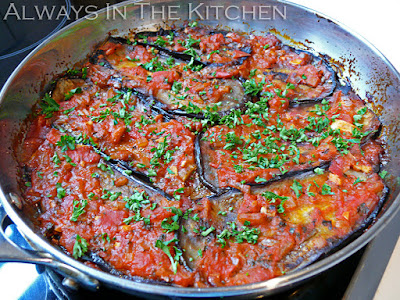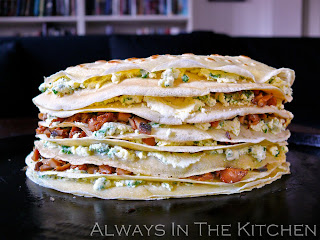
This is an intensely fragrant supper dish with a unique and heady spice signature. It's not quite a one-pot meal, because you roast the vegetables on a tray before adding them in the final cooking stage, however, it is still a simple and delicious meal and the leftovers reheat well. The roasted vegetables lend a subtle sweetness that balances out the spices really beautifully.
Sausage & Butternut Pearl Couscous
Adapted from A Little and a Lot
Serves 4 - 6 depending on hunger and whether or not there are side dishes.
Note about Pearl Couscous: this recipe uses moghrabieh, the largest version of pearl couscous (sometimes called Lebanese Couscous). If you are using a smaller pearl, such as ptitim (aka Israeli couscous), the cooking time for the couscous can be reduced to about 6 or 7 minutes. Test as you cook, to be sure!
Note about butternut squash: butternut squash has an enzyme just beneath its skin that has a peculiar effect on the skin of your hands when you handle it, leaving your hands feeling very tight and dry afterward. This feeling is not solved by simply washing and moisturizing; to avoid this unpleasantness, I recommend that you wear rubber gloves (such as for washing dishes) while you peel. I use a sturdy Y-peeler, which has no difficulty tearing through the tough skin.
750 grams butternut squash, peeled, deseeded, and cut into large dice (about 3 cups)
2 large or three medium carrots, peeled and cut into large dice*
30 ml (2 tablespoons) extra virgin olive oil
1/4 teaspoon salt
1/4 teaspoon ground white pepper
300 grams sausage, such as Andouille, Krakauer, Kielbasa, or any pre-cooked grilling sausage
30 ml (2 tablespoons) butter
250 ml (1 cup) minced shallot (about 1 big banana shallot, or a small onion)
1/2 teaspoon ground cinnamon
4 whole star anise
1/2 teaspoon ground ginger
1/4 teaspoon turmeric
1/2 teaspoon smoked paprika
1/4 - 1/2 teaspoon red pepper flakes
1/2 cup (125 ml) dry white wine or dry vermouth
420 ml (1 3/4 cups) chicken broth or water
12 dried apricots, chopped into six pieces each
225 grams Moghrabieh pearl couscous (if using smaller pearl couscous, reduce cooking time)
1 cup chopped fresh cilantro
Heat the oven to 190°C (375°F) degrees with a rack in the middle position.
Place diced carrot and butternut squash in a large bowl, drizzle with olive oil and salt and pepper, and toss gently to coat. Spread them out on a large, rimmed baking sheet, and roast uncovered for 15 minutes.
While the vegetables roast, slice the sausage into chunky bites. After the carrots and squash have been roasting for 15 minutes, add the sausage slices. Give the pan a shake if necessary to even everything into a roughly single layer, and return to the oven to roast for another 15 minutes. Test one of the larger pieces of squash and carrot to make sure they're tender (if not, roast another five minutes, but they should be fine). If the vegetables and sausage are ready before you need them, simply leave them on their tray on a cooling rack until you're ready for them.
While the vegetables and sausages roast together, combine the spices: cinnamon, star anise, ground ginger, turmeric, smoked paprika, and pepper flakes, together in a small bowl. Heat a large skillet, braising pan or dutch oven over medium heat. Add the butter and, once the butter has melted, add the minced shallots and stir through. Once the shallots are starting to soften, add the pearl couscous. Stir and cook until the onions are translucent, and the pearl couscous is picking up a hint of colour. Add the spices to the skillet, reduce the heat to low, and cook for another 1-2 minutes, stirring constantly.
Pour in the white wine or vermouth, turn the heat up to medium-high and cook, stirring frequently, until much of the wine has evaporated. Stir in the broth or water, bring to a gentle simmer, then add the chopped apricots. Lower the heat enough to maintain a gentle simmer, cover the pan, and let cook for 10-12 minutes (a little less for smaller pearls - test a couscous pearl for doneness, and if necessary, continue to cook until tender). There should still be a little liquid in the pan when the couscous is ready, enough to dress the roasted vegetables once they're added. If your liquid is disappearing too quickly while the couscous cooks, be ready to add a little more - preferably hot water from a recently boiled kettle, so to not disrupt the cooking process.
Once the couscous is tender (or even while it's still a little bit al dente) add the sausage, carrots, and squash to the skillet with the couscous and stir to combine. Let cook gently for another 2-3 minutes to meld the flavours. Remove the pan from the heat and stir in half the cilantro, reserving some to garnish plates.
*Large dice = chunky bite-sized pieces.







































